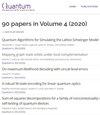直接随机基准理论
IF 5.1
2区 物理与天体物理
Q1 PHYSICS, MULTIDISCIPLINARY
引用次数: 0
摘要
随机基准测试(RB)协议被广泛用于测量一组量子逻辑门的平均错误率。然而,RB的标准版本是有限的,因为它只能间接地对处理器的本机门进行基准测试,通过在组合$n$-qubit Clifford gates中使用它们。标准RB对n量子位Clifford门的依赖将其限制在少量子位,因为典型的复合n量子位Clifford门的保真度随着n量子位的增加而迅速降低。此外,虽然标准RB通常用于推断本地门的错误率,但通过将标准RB的每个Clifford的错误重新缩放为每个本地门的错误,这是一个不可靠的外推。直接RB是一种解决标准RB的这些限制的方法,通过直接对可定制的门集(例如处理器的本机门)进行基准测试。本文详细介绍了直接RB,讨论了如何设计直接RB实验,并提出了两种互补的直接RB理论。这些理论中的第一个使用随机电路中的误差传播或置乱的概念来表明直接RB对于经历随机泡利误差的门是可靠的。我们证明了直接RB衰减是一个单指数,并且在广泛的情况下,衰减率等于基准门的平均不忠度。这一理论表明,可靠的RB并不需要群旋转。我们的第二个理论证明,直接RB对于经历一般门相关马尔可夫误差的门是可靠的,使用与当代标准RB理论相似的技术。我们的两种直接RB理论具有互补的适用性,它们为直接RB为何有效提供了互补的视角。这些理论共同为直接RB的可靠性提供了全面的保证。本文章由计算机程序翻译,如有差异,请以英文原文为准。
A Theory of Direct Randomized Benchmarking
Randomized benchmarking (RB) protocols are widely used to measure an average error rate for a set of quantum logic gates. However, the standard version of RB is limited because it only benchmarks a processor's native gates indirectly, by using them in composite $n$-qubit Clifford gates. Standard RB's reliance on $n$-qubit Clifford gates restricts it to the few-qubit regime, because the fidelity of a typical composite $n$-qubit Clifford gate decreases rapidly with increasing $n$. Furthermore, although standard RB is often used to infer the error rate of native gates, by rescaling standard RB's error per Clifford to an error per native gate, this is an unreliable extrapolation. Direct RB is a method that addresses these limitations of standard RB, by directly benchmarking a customizable gate set, such as a processor's native gates. Here we provide a detailed introduction to direct RB, we discuss how to design direct RB experiments, and we present two complementary theories for direct RB. The first of these theories uses the concept of error propagation or scrambling in random circuits to show that direct RB is reliable for gates that experience stochastic Pauli errors. We prove that the direct RB decay is a single exponential, and that the decay rate is equal to the average infidelity of the benchmarked gates, under broad circumstances. This theory shows that group twirling is not required for reliable RB. Our second theory proves that direct RB is reliable for gates that experience general gate-dependent Markovian errors, using similar techniques to contemporary theories for standard RB. Our two theories for direct RB have complementary regimes of applicability, and they provide complementary perspectives on why direct RB works. Together these theories provide comprehensive guarantees on the reliability of direct RB.
求助全文
通过发布文献求助,成功后即可免费获取论文全文。
去求助
来源期刊

Quantum
Physics and Astronomy-Physics and Astronomy (miscellaneous)
CiteScore
9.20
自引率
10.90%
发文量
241
审稿时长
16 weeks
期刊介绍:
Quantum is an open-access peer-reviewed journal for quantum science and related fields. Quantum is non-profit and community-run: an effort by researchers and for researchers to make science more open and publishing more transparent and efficient.
 求助内容:
求助内容: 应助结果提醒方式:
应助结果提醒方式:


